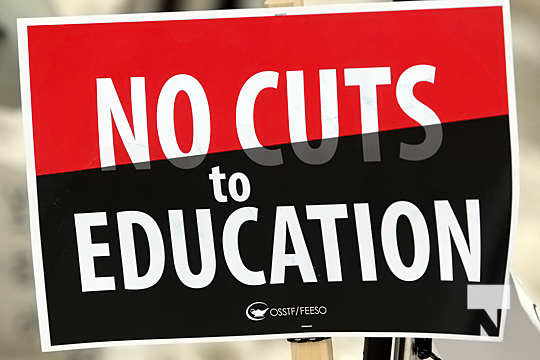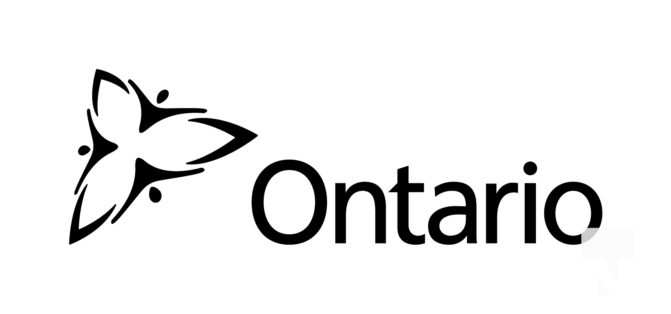By Cecilia Nasmith/Today’s Northumberland
The winter of discontent in Ontario’s 2019-2020 school year has sharpened to anger, as both sides – the provincial government vs. the teachers’ unions – trade accusations of bad faith.
Multiple issues provoked the rotating strikes that have disrupted schools but, as far as the government is concerned, the key one is salaries and benefits.
“We have said from Day One, we want a deal that keeps students in class, that keeps them learning,” Northumberland MPP David Piccini said in an interview Wednesday.
“But we have made it very clear we are not willing to acquiesce to some of the rather large compensation increases. We want our investment to go into front-line support for students and learning, and not to compensation.
“You see one thing on those nicely curated and crafted, highly expensive ads and billboards the unions are buying, but there’s a very different reality of increased compensation and benefits. We have said we want to make this investment in front-line supports.”
Between the 2003-2004 school year and 2017-2018, he said, salaries and benefits rose 80% from $6.5-billion to $11.7-billion. He thought of this during a recent conversation with a single mom who – like many in the community, he said – has not seen her wages and benefits rise 80%.
And while the number of teachers during that time has increased by 12%, the number of students has increased by less than 1%.
“Teachers deserve to be well paid, and they are among the highest-paid in the developed world. The salary for Ontario public-school teachers with 10 years of experience or more are the highest in the country – $94,474 on the average, more than $10,000 more than the Canadian average for teachers.”
Piccini estimated that families are taking the government up on its offer of cash to defray last-minute strike-day day-care arrangements to the tune of almost $300,000 to date.
He suspects it would be more if more people knew about them.
“Among the multi-million-dollar ad campaign by the unions and the simple government website we have, a lot gets lost in the airwaves. We don’t have the deep pockets of the unions, who have hundreds and hundreds of thousands of dollars to launch ad campaigns.”
If so many parents are behind them, Piccini said, why are the unions mounting such expensive ad campaigns, like the recent $600,000 Facebook buy from the Ontario Secondary School Teachers’ Federation.
“This too is taxpayer dollars because, ultimately, these union dues are paid for by taxpayers who pay the teachers.”
Piccini is sold on e-learning, he said, especially after some positive discussions with teachers in his office.
“We put forward a proposal of four courses – of course, with students with exceptionalities, learning difficulties, exceptions will be made. We put forward a proposal to reduce it to two.
“My job is to understand the life-long continuum of education in a world increasingly disrupted by technology. But it also creates new jobs, new sources of income. Employers are increasingly looking for technological competencies. I see increasing incidences of on-line learning in high schools alone – we see a 300% increase already, independent of government policy,” he said.
“My job is wrap our arms around that, prepare the next generation for the future workforce. It’s up to the government to be responsible and to be sure our youth in their upper years of high school prepare for that reality.”
Both sides give different account of negotiations that took place last Friday, how an agreement between both sides was scuttled at the last minute.
“I was out there last week speaking to teachers on the picket line. A lot of them support full-day kindergarten. The minister brings forward a proposal to put in writing to solidify the lowest class-size averages in the nation in early years, a full-day kindergarten model. The unions said, ‘This is not enough.’
“What isn’t enough is compensation and, on that very day, they announced more strike action. Quite frankly, a lot of parents are getting fed up with this.”
A visit that day to a Cobourg picket line on Burnham Street near Terry Fox Public School brings a different account of the meeting.
“I’m here for special education,” said instrumental music teacher and Elementary Teachers’ Federation of Ontario steward Graham Taylor.
This was the issue that scuttled last Friday’s talks, he said.
“The government walked in and said, ‘We will cut you a deal if you take money out of special education.”
“We are here for the most vulnerable. We are here for these children,” he said during a warm-up break at a bus shelter, putting his arm around the shoulders of a couple of children who had joined the picket line.
Fellow ETFO member Michael Kerr – a special-education consultant with the Kawartha Pine Ridge District School Board – said he is adamant about reinstating the $100-million special-education funding that was taken away last spring.
He also said the official demand for a wage increase is 2%. This actually amounts to slightly less than a cost-of-living increase would have provided.
“I’m within one year of retirement. I’m not here for the money, I’m here for the children,” Taylor reiterated.
Kerr characterized their talks with Piccini as less than satisfactory.
“Numerous teachers have spoken to him – he must not understand the issues,” he said.
“I know he was accosted just last week in Brighton. We asked, ‘Why aren’t you coming to the table?’ At that point, it had been going on about 40 days.
“He said, ‘I don’t know. Send me an e-mail.”
“That’s disturbing on one level – confusing and baffling.”
Teachers had class-size caps of 22 when the government announced a new goal of 28 – later reduced to 25.
It was edged up to 22.5 in September, and Kerr is already seeing an increase in such problems as students not being able to get courses they need.
And at the board, he added, they have gone from nine special-ed consultants to cover its large geographic area to three. This gives him responsibilities for 30 Peterborough schools.
The e-learning requirement provokes skepticism, even though the government halved its demand to two mandatory courses – “which is one more than any jurisdiction in the world that we are aware of,” Kerr said.
“They want to monetize it, they want to be able to sell the courses to other jurisdictions, but nobody is buying that, nobody wants that.
“There have been several reports from departments of education in universities indicating it is a substantially poorer learning model for students. They aren’t as engaged, they drop courses more frequently.”
“Particularly students with learning disabilities or special needs. They don’t do well with these courses,” Taylor said.
Kerr characterized them as robot courses taught by a computer.
“There won’t even be a teacher involved. You watch some videos, you answer some questions and the computer will mark it.”
Having just read an article that only about 25% of eligible parents are taking the government up on its offer of per-diem payments to defray special daycare arrangements that must be made because of strike days, he speculated, “The government is saving a whole whack of money there.”
Both said that the teachers feel compelled to continue to fight the government on these various issues.
“We are standing strong. We are not backing down,” Taylor declared.
“The bigger question is really what if we do back down,” Kerr wondered.
“What’s going to happen to the kids in the classrooms? Are parents going to be okay with that? Are the kids?”
























